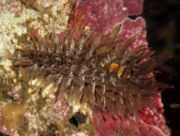
Cerata
Encyclopedia

Nudibranch
A nudibranch is a member of what is now a taxonomic clade, and what was previously a suborder, of soft-bodied, marine gastropod mollusks which shed their shell after their larval stage. They are noted for their often extraordinary colors and striking forms...
sea slug
Slug
Slug is a common name that is normally applied to any gastropod mollusc that lacks a shell, has a very reduced shell, or has a small internal shell...
s, marine opisthobranch gastropod mollusks.
They are dorsal
Dorsum (biology)
In anatomy, the dorsum is the upper side of animals that typically run, fly, or swim in a horizontal position, and the back side of animals that walk upright. In vertebrates the dorsum contains the backbone. The term dorsal refers to anatomical structures that are either situated toward or grow...
and lateral outgrowths on the upper surfaces of the body.
The singular is ceras, which comes from the Greek word "keratos", meaning "horn", a reference to its shape.
Function
Cerata greatly extend the surface area of nudibranchs and aid in respirationAquatic respiration
Aquatic respiration is the process whereby an aquatic animal obtains oxygen from water.-Fish:In most fish respiration takes place through gills. Lungfish, however, possess one or two lungs...
, the process of gas exchange for metabolic use.
Cerata are also used, in some cases, for attack and defense. In many aeolid
Aeolidida
The Aeolidida is a taxonomic clade of sea slugs, specifically aeolid nudibranchs, marine gastropod molluscs in the clade Cladobranchia.-Taxonomy:*Superfamily Flabellinoidea Bergh, 1889**Family Flabellinidae**Family Notaeolidiidae...
nudibranchs, the digestive system extends into the cerata. These nudibranchs eat stinging celled animals (Cnidaria
Cnidaria
Cnidaria is a phylum containing over 9,000 species of animals found exclusively in aquatic and mostly marine environments. Their distinguishing feature is cnidocytes, specialized cells that they use mainly for capturing prey. Their bodies consist of mesoglea, a non-living jelly-like substance,...
ns) such as anemone
Sea anemone
Sea anemones are a group of water-dwelling, predatory animals of the order Actiniaria; they are named after the anemone, a terrestrial flower. Sea anemones are classified in the phylum Cnidaria, class Anthozoa, subclass Zoantharia. Anthozoa often have large polyps that allow for digestion of larger...
s, hydroid
Hydrozoa
Hydrozoa are a taxonomic class of very small, predatory animals which can be solitary or colonial and which mostly live in saltwater. A few genera within this class live in freshwater...
s and sea fan
Sea fan
A gorgonian, also known as sea whip or sea fan, is an order of sessile colonial cnidarian found throughout the oceans of the world, especially in the tropics and subtropics. Gorgonians are similar to the sea pen, another soft coral. Individual tiny polyps form colonies that are normally erect,...
s or bluebottles
Portuguese Man o' War
The Portuguese Man o' War , also known as the Portuguese man-of-war, man-of-war, or bluebottle, is a jelly-like marine invertebrate of the family Physaliidae...
. The stinging cells or nematocyst
Cnidocyte
A cnidocyte, cnidoblast, or nematocyte is a type of venomous cell unique to the phylum Cnidaria . The cnidocyte cell provides a means for them to catch prey and defend themselves from predators. Despite being morphologically simple, lacking a skeleton and usually being sessile, cnidarians prey on...
s are passed unharmed through the digestive system to the tips of the cerata. Here the nematocysts mature and are then used by the nudibranch for its own defence.
In some nudibranchs, cerata are used as decoy tactics. Typically, these cerata are not armed with nematocysts, but when attacked, the nudibranch will autotomise
Autotomy
Autotomy or self amputation is the act whereby an animal severs one or more of its own appendages, usually as a self-defense mechanism designed to elude a predator's grasp...
or drop one or more of its cerata. The dropped cerata produce a sticky secretion and wriggle energetically for some time after being cast off, presumably causing a distraction and allowing the nudibranch to escape.

